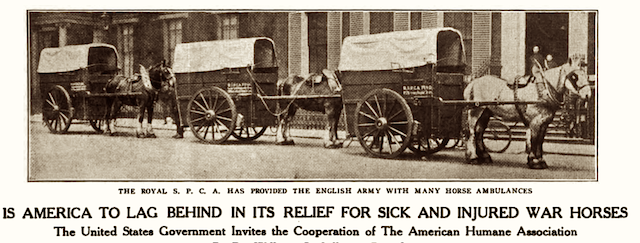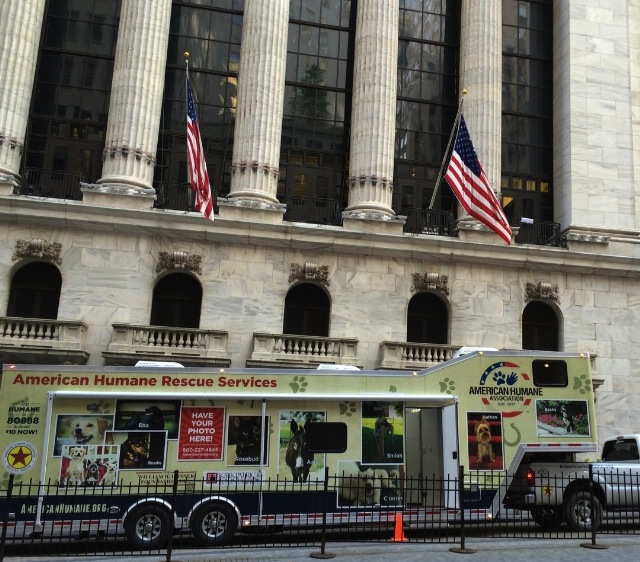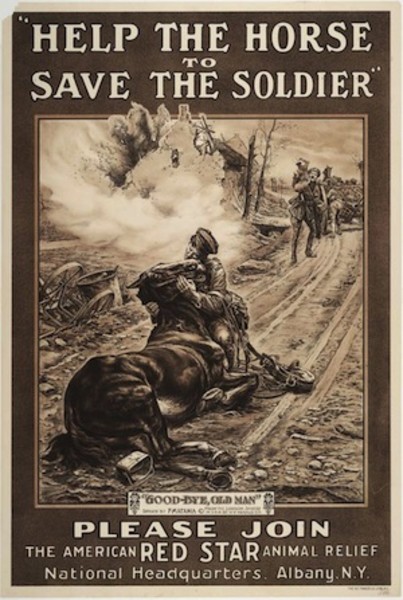New York Stock Exchange’s Opening Bell Peals for War Horse Kindness
- March 10, 2017
- ⎯ Fran Jurga

“…Send not to know For whom the bell tolls, It tolls for thee.” –John Donne, (1572-1631) No Man Is an Island
When the bell clanged this morning to mark the opening of the New York Stock Exchange, you could hear it echo back over 100 years.
The American Humane Association marked 100 years of animal rescue in disasters today with the unveiling of a new dedicated trailer for animal disaster aid. They parked it right in front of the New York Stock Exchange on Wall Street; leading animal health company Zoetis, which has helped fund AHA animal rescue projects, arranged the commemorative bell ringing and people cheered.
But who knows where it all began?

“May marks 100 years since the creation of our legendary animal rescue program, which was born on the battlefield of World War I (in) Europe when the U.S. Secretary of War asked us to save wounded war horses,” said Dr. Robin Ganzert, president of American Humane Association. “During that terrible time, we rescued and cared for 68,000 horses a month and since then we have been part of virtually every major disaster response from Pearl Harbor to 9/11; Hurricanes Andrew and Katrina; the Mount St. Helen’s eruption; the Joplin, Missouri tornado; the Japanese and Haitian earthquakes; and Superstorm Sandy. Over just the past ten years, American Humane Association has saved, helped and sheltered more than 80,000 animals.”
“This new rescue vehicle is a major investment in America’s animals and families,” said Dr. Ganzert. “The newest American Humane Association animal rescue vehicle is specifically designed and outfitted to provide a wide array of animal emergency services and will be a beacon of hope for communities reeling from disasters. We already have giant rescue trucks stationed to protect the Northeast, the Southeast, and the Rocky Mountain area. This strengthening of our nation’s emergency operations is a great gift and we thank the William H. Donner Foundation, Kirkpatrick Foundation, and the other major donors in this effort who care about the most vulnerable in times of greatest need.”

Today, we tend to think of the American Humane Association as the agency that works with the film industry to assure that the “No animals were harmed in the making of this film” label in the final credits is true. The organization actually has many projects, causes and campaigns but the animal disaster preparedness program is one we don’t hear about until it is in action.
Funded by the Kirkpatrick Foundation, the William H. Donner Foundation (in memory of the late Belinda Donner), and others, the rescue vehicle will be stationed in Oklahoma’s Tornado Alley, debuting on May 20th, which will be the anniversary of the EF-5 tornado that devastated the city of Moore in 2013.
Following that disaster, American Humane Association’s Red Star® Rescue team deployed for a full month, helping to rescue, shelter, and care for hundreds of animals. Oklahoma City’s Kirkpatrick Foundation helped to fund those efforts.

The long-range vision of the Kirkpatrick Foundation may surprise some readers; this is not just another faceless philanthropic fund. “We are committed to improving the quality of life for all animals in our state,” said Louisa McCune, executive director of the Foundation. “In fact, by the year 2032, we want Oklahoma to become the best place in the United States—and the world over—to be an animal.”
About the AHA animal rescue vehicles:

“This new rescue vehicle is a major investment in America’s animals and families,” said Dr. Ganzert. “The newest American Humane Association animal rescue vehicle is specifically designed and outfitted to provide a wide array of animal emergency services and will be a beacon of hope for communities reeling from disasters.
“We already have giant rescue trucks stationed to protect the Northeast, the Southeast, and the Rocky Mountain area. This strengthening of our nation’s emergency operations is a great gift and we thank the William H. Donner Foundation, Kirkpatrick Foundation, and the other major donors in this effort who care about the most vulnerable in times of greatest need.”
The dedication event during the opening bell of the New York Stock Exchange was made possible by the animal health company Zoetis, which funded the American Humane Association rescue vehicle protecting the animals of the Northeast.
This video was made a few years ago, but it documents the decades of Red Star animal relief projects.
The American Humane Association and Red Star have a deep and fascinating history. While the organization certainly did wonderful work in World War I, it also produced emotional animal-centric propaganda-type fundraising campaigns. Professor Janet Davis of the University of Texas presented her research on that subject at War Horses Conference at the University of London in 2014.
Her lecture, “Where Gasoline Can’t Go: Equine Patriotism and the American Red Star Animal Relief Campaign during World War I” outlines how the International Red Star Alliance began in 1914 with an office in Geneva, Switzerland, which was also the home of the Red Cross. Their mission: to work on behalf of sick or wounded war animals and to secure the neutralization of persons engaged in such work.

The fledgling American Red Star used the Geneva organization as a model. Political neutrality is reflected in AHA publications in the early years of World War I, which show German troops’ treatment of animals. World War I waged for three years before the United States officially joined the allies; during that time, Red Star was hard at work, but also campaigning for American preparedness through horses that were well-cared for, and for the employment of more veterinarians in the US military.
The AHA, Red Star and other humane groups researched and reported on countless improvements to animal health and husbandry that could benefit horses in the war. The horse ambulance was certainly one of these and the most visible. It is also the one most touted in AHA history documents, perhaps because the scope of Red Star efforts during World War I was so broad, and so intense.
Red Star fundraising appeals even suggested that the United States was not prepared for war because of the sheer numbers of our horses that had been purchased by British and French agents and shipped to Europe. Red Star also criticized the conditions under which horses were shipped to Europe. By 1918, Red Star rhetoric included the concept of “horse conservation” being in the best interest of the nation.
As a consequence of the Red Star’s prolific publication of animal-related views of how humans in war (and peace) should treat animals, the organization became the de facto enemy of motorized vehicle proponents who sought to replace horses in every facet of transportation, commerce and agriculture.
The early part of the 20th century was a crucial turning point in the status of horses in North America. How different might things be today if Red Star, the American Humane Association, and other horse advocacy organizations hadn’t fought on the behalf of horses? How different might the outcome of World War I have been without Red Star efforts?
That bell in New York this morning should echo around the world, and down through the years.
HISTORIC TIMELINE:
To see an historic timeline with photos capturing 100 years of American Humane Association’s animal rescue work, click on this link:
http://kindness100.org/pdfs/100-years-of-animal-rescue.pdf
.
————————
Posters displayed in this article courtesy of the University of North Carolina collection of war propaganda posters:
Albany, N.Y.: American Red Star Animal Relief, [between 1914 and 1918].
Matania, Fortunino, b. 1881.“Help the Horse to Save the Soldier” : Please Join the American Red Star Animal Relief…
Albany, N.Y.: American Red Star Animal Relief, [between 1914 and 1918].





